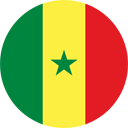Step 7 : Adjectives in Wolof
Adjectives are used to describe nouns. To get started, we suggest you learn the three Wolof adjectives rëy, tuuti and yàgg (big, small, old). Using the nouns teere, siis and bunt (book, chair, door) which you learned in Step 3, learn to use each adjective with each noun (the big book, the old chair, the small door). You can scroll to the top of this page to see a short lesson about Wolof adjectives including useful examples. After you've learned to use the adjectives rëy, tuuti and yàgg with the nouns teere, siis and bunt you can move on to Step 8 (Wolof Verbs).






